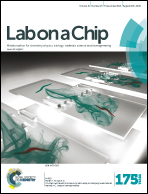A bubble- and clogging-free microfluidic particle separation platform with multi-filtration
Abstract
Microfiltration is a compelling method to separate particles based on their distinct size and deformability. However, this approach is prone to clogging after processing a certain number of particles and forming bubbles in the separation procedure, which often leads to malfunctioning of devices. In this work, we report a bubble-free and clogging-free microfluidic particle separation platform with high throughput. The platform features an integrated bidirectional micropump, a hydrophilic microporous filtration membrane and a hydrophobic porous degassing membrane. The bidirectional micropump enables the fluid to flow back and forth repeatedly, which flushes the filtration membrane and clears the filtration micropores for further filtration, and to flow forward to implement multi-filtration. The hydrophobic porous membrane on top of the separation channel removes air bubbles forming in the separation channel, improving the separation efficiency and operational reliability. The microbead mixture and undiluted whole blood were separated using the microfluidic chip. After 5 cycles of reverse flushing and forward re-filtration, a 2857-fold enrichment ratio and an 89.8% recovery rate of 10 μm microbeads were achieved for microbead separation with 99.9% removal efficiency of 2 μm microbeads. After 8 cycles, white blood cells were effectively separated from whole blood with a 396-fold enrichment ratio and a 70.6% recovery rate at a throughput of 39.1 μl min−1, demonstrating that the platform can potentially be used in biomedical applications.



 Please wait while we load your content...
Please wait while we load your content...